Great Dixter, Sussex: The Residence of Mr. Nathaniel Lloyd by Lawrence Weaver
From the Country Life Archive: Lawrence Weaver reports on Great Dixter, Sussex. Originally published in Country Life, January 4, 1913.

RETURN TO THE GREAT DIXTER HOMEPAGE
Southern Kent and East Sussex are peculiarly rich in early timber houses which reveal the simple plan that contented our mediaeval forbears. Though all of them have been altered to fit them for less simple conditions of life, their general arrangement can readily be disentangled. Most of them were yeomen's houses, and the only one in that district which can claim to be a manor house of dignity is Great Dixter, near Northiam, the subject of our pictures.
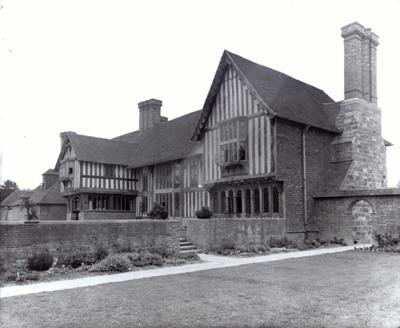
Fig 1. Entrance from the north-west.
It is necessary to enter into the early ownership of the manor in some detail, because of the light thrown thereby on the date of what must be regarded as one of the most important and perhaps the earliest timber house in Sussex. There was an Adam de Dyksters in 1295, and in 1340 one Hamo at Gate was liable to find one man-of-arms in respect of his land in Dicksterve. Hamo's daughter Joan married Robert Echingham, and on their death, Dixter passed to the descendants of Robert's younger brother, Richard. Another Robert Echingham was in possession in 1411. His daughter, Elizabeth, married Richard Wakehurst, who died in 1454, leaving his widow in possession until her death in 1464. Their son had died young, leaving two daughters, under the guardianship of their grandmother, Elizabeth Wakehurst, and of Richard's brother-in-law, John Gaynesford. The two girls were entrusted to Gaynesford's sister Agnes, wife of Sir John Culpeper, who quite probably was privy to their abduction and marriage by his two brothers, Richard and Nicholas. This exploit was doubtless inspired by the intent to secure Dixter for the girls when their grandmother died but by Richard Wakehurst's marriage settlement the manor was to go back to the Echingham family in default of male Wakehurst heirs. Sir Thomas Echingham accordingly succeeded, and was followed by his daughter Margaret, whose second husband was Sir John Elrington. We know that Sir John was in possession of Dixter in 1479, because he was granted licence to crenellate and fortify the manor in that year, and he died in 1483, leaving to Margaret his household stuff at Dixter. Shortly afterwards, the two Culpepers who had married the two Wakehursts claimed the manor from the widow, but she had powerful friends. One of her daughters by her first marriage had married Andrew Windsor, who afterwards became Lord Windsor, and he stood by her. The lawyers were busy with the quarrel for several years, and it was complicated by the efforts of other claimants, which need not be described. To make a long story short, the Culpepers failed in their suits, and when Dame Margaret Elrington died, the property passed to the Windsor family, with whom it remained until 1595. It was then purchased by John Glydd, but in 1640 his family ended in three heiresses, who subdivided the property and the later story of the manor need not concern us. It is often called Big Dixter in early records. Little Dixter, near by, is an Elizabethan house, but it is not of the hall type.
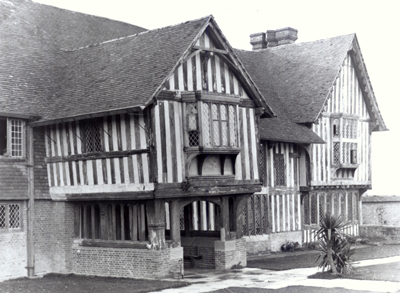
Fig 2. Porch from the north-east.
A few years ago Mr. J. E. Ray wrote a most interesting paper on Great Dixter, which was then disfigured by modern accretions, such as the two floors which had been inserted across the great hall. His analysis of the building is a valuable contribution to the development of timber "hall houses," but the accuracy of the date to which he attributes the building of Dixter may be doubted. Judged merely by the architectural evidence of its fabric, the house can safely be placed between 1440 and 1480, but Mr. Ray suggests that the heraldic devices on the hall roof enable us to narrow this down considerably. Among the shields of arms is that of the Gaynesfords. Mr. Ray points out that one of them became interested in the manor after the death, in 1464, of Elizabeth Wakehurst, but even then it was not as owner, but only as trustee. He suggests that it is unlikely that the Gaynesford arms could have been carved long after the building was finished, and decides on 1464 as the earliest date to which we can assign the hall. This theory, however, requires examination. On the death of Elizabeth Wakehurst, as we have already seen, the manor returned to Sir Thomas Echingham, but there seems no reason why, if he built the house, he should have carved on the roof the arms of John Gaynesford, with whom, as the guardian of the two girls who were claiming the estate against him, he can scarcely have been on good terms. On the other hand, if Richard Wakehurst, who married Elizabeth Echingham, the heiress of Dixter, built the hall, it would have been a very natural thing for him to set up the arms of his brother-in-law, who belonged to a family distinguished in the locality. The analogy afforded by many other houses shows that there is no occasion more fruitful of building than the advent of a man to an estate of which he marries the heiress. It seems reasonable, therefore, to attribute the hall to some date between 1440 and 1454. Even if that be not true, it must have been finished before 1479, when Elrington was in possession, or his arms would appear with those of Echingham and Gaynesford on the hammer-beams, one of which shows an empty shield. If, however, we are correct in the attribution to Richard Wakehurst, he was a builder with original ideas. The hall is a noble apartment, and runs up three storeys in height. It measures forty feet by twenty-five feet - about double the size of the hall of a yeoman's house - and the construction is particularly interesting. It is divided into four bays by great oak posts, which extend from the ground to the eaves and form the vertical framework of the building. On top of them, and running through the length of the house, are big timbers, which form the wall plate. The unusual feature at Dixter is that, while these uprights are connected across the hall at its lower end, and also in the middle, by tie-beams, the intermediate posts dividing the solar from the first bay, the first from the second, and the third from the fourth, are furnished only with three pairs of short hammer-beams. This construction is certainly rare, and possibly unique, in a large building wholly of timber, as it is much better adapted for use with stone walls. On the ends of these hammer-beams, and fixed at a slope, so that they look down to the hall at an angle of 45deg., are shields of arms bearing the following cognisances: the fret of the Echinghams, the engrailed cross of the Dalyngrugges and three greyhounds between a chevron for the Gaynesfords.
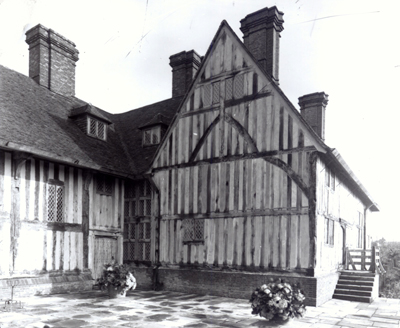
Fig 3. A corner of the south-terrace.
Exquisite houses, the beauty of Nature, and how to get the most from your life, straight to your inbox.
When the hall was built, there was an open hearth on the floor from which the smoke found its way out by the windows or through chinks in the roof, or by a louvre, just as it did in the notable case of Penshurst. The roof timbers show by their blackened surfaces the inconvenience that fifteenth-century folk were ready to suffer. At the upper or west end of the hall there was a dais, on which stood the dining-table for the owner and his family. Mortice holes in the posts at the end of the wall remain to show that the dais floor was about fifteen inches above the general level of the hall, which in those days was sometimes known as the "marsh." As it was usually of beaten earth, strewn with rushes, and mingled with scraps of food and bones, this name seems to be apt enough. An examination of the building goes to show that the apartment opening out of the west of the hail, with the room above it, and the porch are of later date. It may be that Richard Wakehurst died before his work was done, and that the family disturbances which followed caused operations to be suspended until the succession of Margaret Echingham and her husband, Sir John Elrington. The ground floor room in houses of this type is ordinarily called the "cellar," but this is a misleading description at Dixter, because there is a real cellar beneath it. The room on the upper floor is the solar and runs up two storeys. These two west rooms were the private and sleeping apartments of the family, to which they retired after eating in hall. At the south end of the hall dais was a doorway to the staircase which led up to the solar, but unhappily all traces of the original staircase work have disappeared. The solar itself had originally two fine tie-beams, which supported the king-posts of its handsome open roof. One of these has been cut away, but the other remained intact. Both the solar and the parlour below had big stone fireplaces. The one in the solar remains in an admirable condition, but is rather puzzling, as it reveals on the spandrels of its carved mantel-piece the hawk's lure of the Lewknor family, who were associated with Bodiam Castle, and the antlered head of the Windsor family. Presumably this fire place was added later; it can hardly have been adorned with the Windsor cognisances by Elrington. Unhappily the fireplace in the room below has been hopelessly mutilated. That the rooms were in full use during the sixteenth century is shown by the legend scratched on the beam of the parlour, which runs as follows:
"JOHN HARRISON DWELLT ATT DIXTERN XXXVI YERS AN VI MONTHES. CAME YE FERST OF ELISAHETHE RAIN."
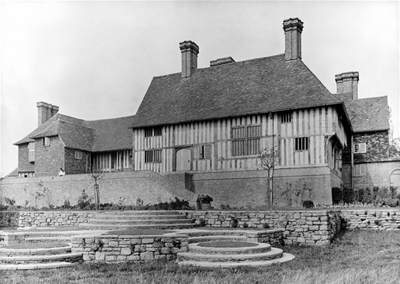
Fig 4. The south side with Benenden House in the foreground.
It is probable that when Lord Windsor and his wife entered into their inheritance they did something which added to the amenities of Dixter, but their chief seat was at Stanwell in Bucks. The first baron died in 1543 and his successor in 1558. The Windsors leased Dixter to the father of the John Harrison who, in 1595, or thereabouts, scratched the inscription already quoted.
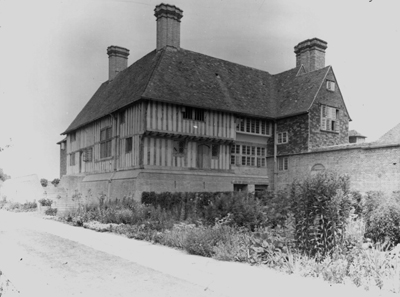
Fig 5. From the south-east.
A glance at the plan will show that nothing remains of the old house of Dixter but the hall, solar and porch already described, but there are clear evidences as to how the east end was treated. Crossing the hall there was a screen, perhaps with a gallery over, and into this entry, commonly called "the screens," the porch would have given. Two doors would open into the hall and two to the left into buttery and pantry. Servants' rooms would be provided over the latter, and probably the room above the porch had a door from the screen gallery. By the end of the sixteenth century, people were getting tired of being smoke-dried in the hall, and were building fireplaces at the lower or buttery end of it. It is a probable theory that when John Harrison died or left Dixter in 1595 the new owner, John Glydd, remodelled the house, built the great chimney and divided the open hall into three storeys. The mantel-beam of the similar but smaller house at Benenden was dated 1595, which marks the time at which other places in the neighbourhood were being converted. From the beginning of the seventeenth century and for three hundred years the main fabric suffered little save for the usual insertion of sliding sashes and other minor alterations. When Mr. Lloyd acquired Dixter it presented in some ways a rather woeful appearance, but it was sound in its bones. In one respect the task of restoration was easy, for there was no work of later than the fifteenth century which had any intrinsic merit entitling it to continued existence.
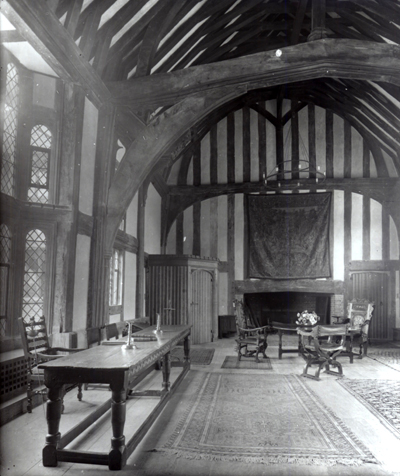
Fig 6. The hall: looking eastwards.
All the additions to the original house were sheer defacements. Mr.
Lutyens was the architect for the work, and his handling of it has been
altogether admirable. It is obvious that when the two added floors which
cut up the hall, and that which divided the solar and all the cross
partitions had been cleared out, the rooms available, though large, were
few, and it was necessary to decide how the needful accommodation
should be provided. Mr. Lloyd and Mr. Lutyens made visits to many of the yeoman's hall houses in the neighbourhood in order to mark the local peculiarities of treatment, and among them was the typical house at
Benenden in Kent, which was known as "The Old House at Home.'' It was very dilapidated, and the great chimney-stack had lately collapsed and broken down the floors and partitions in its fall. Its owner was then
arranging to demolish the framework, and Mr. Lloyd bought it. The
transplanting of houses from their original site is generally a
meaningless proceeding, greatly to be deprecated; but in this case it
was amply justified. Indeed, in no other way, could a valuable example
of timber building have been spared. It was accordingly rebuilt to the
south-east of the Dixter house. All the timbers were numbered and
photographed before being taken down and carried to the new site, and
the Benenden house was connected with the Hall of Dixter by a wholly new eastern wing. In designing the latter, Mr. Lutyens has made no sort of attempt to imitate the timber construction of the two old houses, but
has built in brick and weather-tiling.

Fig 7. The hall: west end.
Nor were any, alterations or restorations made in the old work save
where absolutely necessary. Neither dais nor screen was set up afresh in
the great hall. The big fireplace in the hall was built against its
east wall, but in the new wing. Adjoining it in the north-east corner
was provided an infernal wind-porch to keep the hall warm and
comfortable. The parlour at the west end had been divided by a partition
into two rooms, and this convenient arrangement was retained. As the
unlovely additions of the nineteenth century mostly, of lath and
plaster, were one by one removed, a window here and a moulding there
came to light, damaged sometimes, but not so far that renewal could not
be done with certainty rather than conjecture to guide it. Some of the
windows had originally been filled, not with glass, but with shutters
sliding in grooves, and the latter remained. By great good fortune one
of the ancient shutters of the Benenden house had survived, and new ones were made from it for use in two pairs of pointed windows in the porch room.

Fig 8. On the stairs.
In the Benenden hall, now the chief bedroom at Dixter, the upright bars,
which were provided as a protection to the shuttered openings, have
survived, and the openings have been glazed behind them on one side, but boarded up on the other, as seen in our picture. This yeoman's hall
never boasted a screen, but the crenellated beam which crossed the hall
at the upper end was returned two feet into the room to screen the
master of the house from the neighbouring door as he sat at meat. This
interesting feature remains. The warming of a mediaeval house is rather a problem. Radiators strike an unduly modern note, but they are a
necessity, especially in rooms with open roofs. At Dixter, their cases
are mainly, old oak chests with chases suitably contrived to allow free
circulation of the warmed air. In one example, the radiator case serves as a wash-stand.

Fig 9. The solar.
The planning of the new wing is ingenious, as the two old houses are
perfectly connected, but they are yet allowed to stand out freely from
each other and from the connecting wing. The north or entrance front is
Dixter, the south or garden side Dixter and Benenden. As the ground
sloped rapidly to the south, the yeoman's house had to be set up on a
brick substructure, with which is linked a delightful scheme of terrace
and stairways. The group of steps, round on plan, which appears in our
fifth picture, is very characteristic of Mr. Lutyens inexhaustible
invention. In the treatment of the garden the same conservatism which
informed the repair of the house has been the keynote. All the old farm
buildings have been retained. The orchard comes up to the lower terrace
with its flagged walk over a hundred yards long. On one side of this
walk is the great herbaceous border. A tiled cattle-hovel became a
garden shelter and the yard in front of it a formal rose garden; another
hovel became a fruit-house. Not so long ago oxen ploughed the Dixter
land, and there remained an ox-yard with its thatched hovel where the
beasts sheltered. This yard is another garden, and the shed makes a
children's play-house. Another great thatched barn serves as a garage
and generating station.
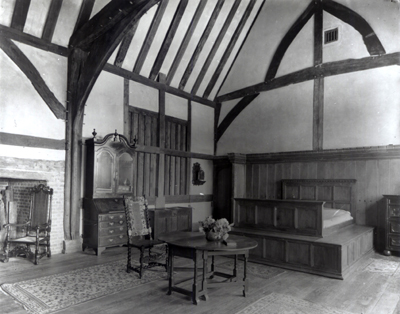
Fig 10. The hall of the Benenden House.
All these farm buildings have been added from time to time regardless of
right angles or of any relation to each other or to the house. Yet so
skilfully has Mr. Lutyens linked them up by various features which mask
the riot of contending lines that the combined effect is wholly restful
and coherent. As time goes on, doubtless many more such houses as Great Dixter will be rescued from neglect and will reveal again the delightful craftsmanship of later mediaeval times. It will be fortunate if they are restored by an owner so sympathetic and by an architect who so
justly combines the antiquary with the artist.
Photographs: 1-10 by Country Life. All images are available for purchase from the Country Life Picture Library.
RETURN TO THE GREAT DIXTER HOMEPAGE
EVERGREEN HEDGES: SOME OBSERVATIONS ON THEIR PLANTING AND GROWTH BY H. AVRAY TIPPING
GREAT DIXTER ROUND THE YEAR BY CHRISTOPHER LLOYD (FREE PDF DOWNLOAD)
GREAT DIXTER, SUSSEX: THE HOME OF MR. CHRISTOPHER LLOYD BY CHARLES HIND (FREE PDF DOWNLOAD)
35 YEARS IN MY GARDEN BY CHRISTOPHER LLOYD (FREE PDF DOWNLOAD)
Agnes has worked for Country Life in various guises — across print, digital and specialist editorial projects — before finally finding her spiritual home on the Features Desk. A graduate of Central St. Martins College of Art & Design she has worked on luxury titles including GQ and Wallpaper* and has written for Condé Nast Contract Publishing, Horse & Hound, Esquire and The Independent on Sunday. She is currently writing a book about dogs, due to be published by Rizzoli New York in September 2025.
